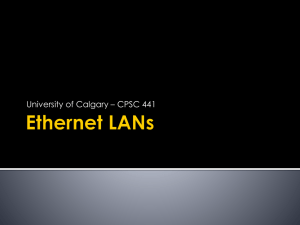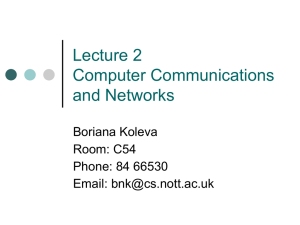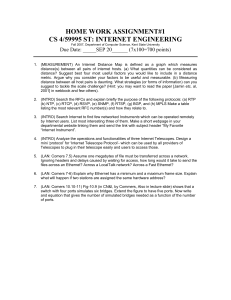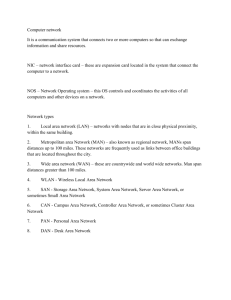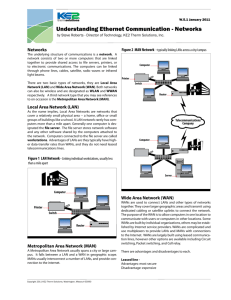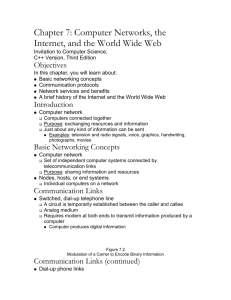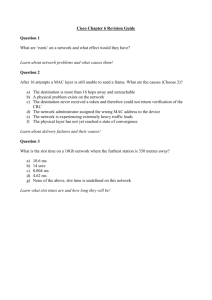Chapter 15 Local Area Networks
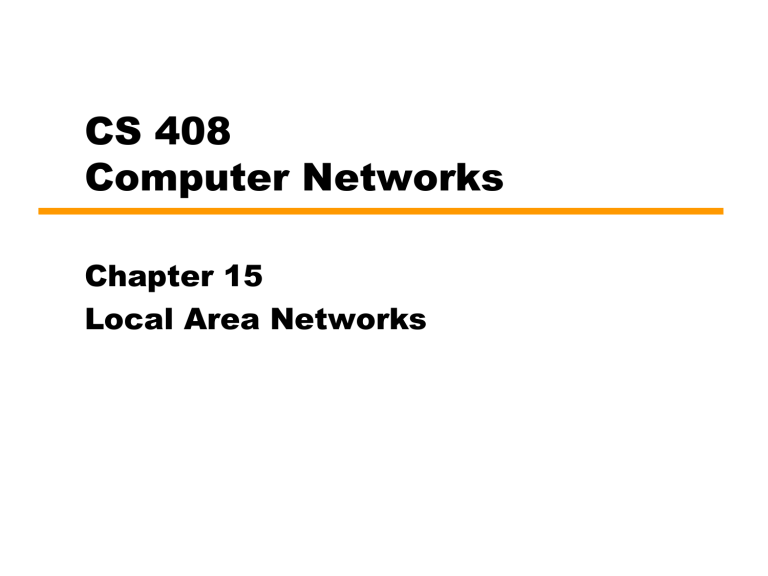
CS 408
Computer Networks
Chapter 15
Local Area Networks
LAN (Local Area Networks)
• A LAN is a computer network that covers a small area
(home, office, building, campus)
— a few kilometers
• LANs have higher data rates (10Mbps to 40Gbps) as compared to WANs
• LANs (usually) do not involve leased lines; cabling and equipments belong to the LAN owner.
• A LAN consists of
— Shared transmission medium
• now so valid today due to switched LANs (for wired LANs), but still valid for wireless LANs
— regulations for orderly access to the medium
— set of hardware and software for the interfacing devices
LAN Protocol Architecture
• Corresponds to lower two layers of OSI model
— But mostly LANs do not follow OSI model
• Current LANs are most likely to be based on
Ethernet protocols developed by IEEE 802 committee
• IEEE 802 reference model
— Logical link control (LLC)
— Media access control (MAC)
— Physical
IEEE 802 Protocol Layers vs.
OSI Model
IEEE 802 Layers - Physical
• Signal encoding/decoding
• Preamble generation/removal
— for synchronization
• Bit transmission/reception
• Specification for topology and transmission medium
802 Layers - Medium Access
Control & Logical Link Control
• OSI layer 2 (Data Link) is divided into two in IEEE 802
— Logical Link Control (LLC) layer
— Medium Access Control (MAC) layer
• LLC layer
— Interface to higher levels
— flow control
— Based on classical Data Link Control Protocols (so we will cover later)
• MAC layer
— Prepare data for transmission
— Error detection
— Address recognition
— Govern access to transmission medium
• Not found in traditional layer 2 data link control
LAN Protocols in Context
Generic MAC & LLC Format
• Actual format differs from protocol to protocol
• MAC layer receives data from LLC layer
• MAC layer detects errors and discards frames
• LLC optionally retransmits unsuccessful frames
LAN Topologies
• Bus
• Ring
• Star
Bus Topology - 1
• Stations attach to linear medium
(bus)
— Via a tap - allows for transmission and reception
• Transmission propagates in medium in both directions
• Received by all other stations
— Not addressed stations ignore
• Need to identify target station
— Each station has unique address
— Destination address included in frame header
• Terminator absorbs frames at the end of medium
Bus Topology - 2
• Need to regulate transmission
— To avoid collisions
• If two stations attempt to transmit at same time, signals will overlap and become garbage
— To avoid continuous transmission from a single station. If one station transmits continuously, access is blocked for others
• Solution: Transmit Data in small blocks – frames
Ring Topology
• Repeaters joined by pointto-point links in closed loop
— Links are unidirectional
— Receive data on one link and retransmit on another
— Stations attach to repeaters
• Data transmitted in frames
— Frame passes all stations in a circular manner
— Destination recognizes address and copies frame
— Frame circulates back to source where it is removed
• Medium access control is needed to determine when station can insert frame
Frame
Transmission
Ring LAN
Star Topology
• Each station connected directly to central node
— using a full-duplex
(bi-directional) link
Hub or Switch
• Central node can broadcast (hub)
— Physical medium star , but logically like bus due to broadcast
— Only one station can transmit at a time; otherwise, collision occurs
• Central node can act as frame switch
— retransmits only to destination
— today’s technology
Medium Access Control (MAC)
• Traditionally, in LANs data is broadcast
— there is a single medium shared by different users
• We need MAC sublayer for
— orderly and efficient use of broadcast medium
• This is actually a “channel allocation” problem
• Synchronous (static) solutions
— everyone knows when to transmit
• Asynchronous (dynamic) solution
— in response to immediate needs
— Two categories
• Round robin
• Contention
Static Channel Allocation
• Frequency Division
Multiplexing (FDM)
• Channel is divided to carry different signals at different frequencies
• Efficient if there is a constant
(one for each slot) amount of users with continous traffic
• Problematic if there are less or more users
• Even if the amount of users =
# of channels, utilization is still low since typical network traffic is not uniform and some users may not have something to send all the time
Static Channel Allocation
• Time Division Multiplexing
• Each user is statically allocated one time slot
— if a particular user does not have anything to send, it remains idle and wastes the channel for that period
— A user may not utilize the whole channel for a time slot
• Thus, inefficient.
Dynamic Channel Allocation
Categories
• Round robin
— each station has a turn to transmit
• declines or transmits up to a certain data limit
• overhead of passing the turn in either case
— Performs well if many stations have data to transmit for most of the time
• otherwise passing the turn would cause inefficiency
Dynamic Channel Allocation
Categories
• Contention
— All stations contend to transmit
— No control to determine whose turn is it
— Stations send data by taking risk of collision (with others’ packets)
• however they understand collisions by listening to the channel, so that they can retransmit
— There are several contention methods
— In general, good for bursty traffic
• which is the typical traffic types for most networks
— Efficient under light or moderate load
— Performance is bad under heavy load
Ethernet (CSMA/CD)
• Carriers Sense Multiple Access with Collision
Detection
— is the underlying technology (protocol) for medium access control
• Xerox – Ethernet (1976) by Metcalfe
• IEEE 802.3 – standard (1983)
• Contention technique that has basis in famous
ALOHA network
ALOHA
• Packet Radio (applicable to any shared medium)
— initially proposed to interconnect Hawaiian Islands (several stations)
• by Norman Abramson of Univ. of Hawaii (early 70s)
• Later inspired the designers of Ethernet
• When station has frame, it sends
— collisions may occur
• Station listens for max round trip time
• If no collision, fine. If collision, retransmit after a random waiting time
— Collison is understood by listening or by having no acknowledgement (two alternatives – see the notes of this slide)
• Max channel utilization is 18% - very bad
Slotted ALOHA
• Divide the time into discrete intervals (slots)
— equal to frame transmission time
— need central clock (or other sync mechanism)
— transmission begins at slot boundary
• Collided frames will do so totally or will not collide
• Algorithm
— If a node has a packet to send, sends it at the beginning of the next slot
— If collision occurred, retransmit at the next slot with a probability
• Why with a probability?
• Max channel utilization is 37%
— doubles Normal ALOHA, but still low
CSMA (Carrier Sense Multiple
Access)
• First listen for clear medium (carrier sense)
• If medium idle, transmit
• If busy, continuously check the channel until it is idle and then transmit
• If collision occurs
— Wait random time and retransmit (called back-off )
• Collision probability depends on the propagation delay
— Longer propagation delay, worse the utilization
• Collision may occur even if the propagation time is zero.
— WHY?
• 1-persistent CSMA
• Better utilization than ALOHA
Nonpersistent CSMA
• Patient CSMA
• If channel idle, send
• If not, do not continuously seize the channel
— instead wait a random period of time
• Better utilization, longer delay
p-Persistent CSMA
• Applies to slotted channels
• If channel is busy, then check the next slot
• If channel is idle
— send with a probability p
— defer until the next slot with probability 1 – p
— repeat this algorithm until it sends or channel becomes busy by another station
• if channel becomes busy in one of these slots, wait until channel is available and repeat the same algorithm
• if collision occurs, then wait a random period of time and repeat the same algorithm
• larger p means smaller channel utilization and smaller waiting time for the packets
All CSMA Persistence schemes altogether
CSMA/CD (IEEE 802.3 – Ethernet)
• As in 1-persistent CSMA, but uses slotted channels
— If medium idle, transmit
— If busy, listen for idle slot, then transmit
• In regular CSMA, collision occupies medium for duration of transmission
— it is inefficient to complete the transmission of a collided packet
• In CSMA/CD, stations listen while transmitting
• If collision detected (due to high voltage on bus), cease transmission and wait random time then start again
— random waiting time is determined using binary exponential backoff mechanism
CSMA/CD
Operation
Binary exponential back off
• random waiting period but consecutive collisions increase the mean waiting time
— mean waiting time doubles in the first 10 retransmission attempts
— after first collision, waits 0 or 1 slot time (selected at random)
— if collided again (second time), waits 0, 1, 2 or 3 slots (at random)
— if collided for the i th time, waits 0, 1, …, or 2 i -1 slots (at random)
— the randomization interval is fixed to 0 … 1023 after 10 th collision
— station tries a total of 16 times and then gives up if cannot transmit
• low delay with small amount of waiting stations
• large delay with large amount of waiting stations one slot time = max. round trip delay
50 microsecs in 10 Mbps
Ethernet (see next slide for details of this value)
CSMA/CD - Details of Contention
• No acknowledgments in CSMA/CD, so sending station must make sure that:
— all other stations are aware of its transmission and
— there is no collision on the channel
• so the sending station has to continue transmission for a duration of the worst case scenario in which understanding a collision takes as long as the round trip time
— this is closely related to the length of the cable (bus) and the propagation speed
— for 2500 meters of coax cable (standard for 10 Mbps
Ethernet), round trip time is approx 50 microseconds
Minimum Frame Size
• Previous discussion also has minimum frame size implication
— at 10 Mbps: one bit takes 100 ns to be transmitted
— In order to occupy the channel during 50 microsecs
• one frame at minimum should be 500 bits
• plus some safety margins and rounding, minimum frame size is set to 512 bits (64 bytes) in IEEE 802.3
IEEE 802.3 Frame Format
>= >=
Preamble is alternating 0’s and 1’s (for clock synchronization)
SFD is 10101011
Length is of the LLC data
FCS is 32-bit CRC (Cyclic Redundancy Check) code and excludes
Preamble and SFD
Addresses are uniquely assigned by IEEE to manufacturers. Why unique?
CSMA/CD Performance
• Formulation for utilization utilization = transmission time / (trans. time + all other)
If no collisions U = T trans
/ (T trans
+ T prop
)
With collisions U = T trans
T contention
/ (T trans
+ T prop
+ T contention
) is the time spent for collisions to send a frame
We have seen how to formulate trans. and prop. delays before. Now we shall see (on the board) how to formulate contention time
10Mbps Medium Options
• 10Base2
— Thick coax - obsolete
• 10Base5
— Thin coax
— Bus topology
— 500meters max segment length
• max 5 segments connected via repeaters max. 2500 meters
— Max. 100 stations per segment
• 10BaseT
— most commonly used 10 Mbps option (see next slide)
• 10BaseF
— Optical fiber
— star topology or point to point
— too expensive for 10 Mbps
10BASE-T
• Unshielded twisted pair (UTP) medium
— regular telephone wiring
• Point to point using cross-cables
• Star-shaped topology
— Stations connected to central hub or switch
— Two twisted pairs (transmit and receive)
— Hub accepts input on any one line and repeats it on all other lines
• Physical star, logical bus
• collisions are possible
• Link limited to 100 m
• Multiple levels of hubs can be cascaded
An Example Two-Level Star
Topology
Interconnection Elements in
LANs
• Hubs
• Bridges
• Switches
• Routers
Bridges
• Need to expand beyond single LAN
• Interconnection to other LANs and WANs
• Use Bridge or Router (Switches can also be used)
• Bridge is simpler
— Connects similar LANs
— Identical protocols for physical and link layers
— Minimal processing
• Router is more general purpose
— Interconnect various LANs and WANs
Functions of a Bridge
• Read all frames transmitted on one LAN and accept those addressed to any station on the other LAN
• Retransmit each frame on second LAN
• Do the same the other way round
Bridge Operation Example
Bridge Design Aspects
• No modification to content or format of frame
• No additional header
• Exact bitwise copy of frame from one LAN to another
— that is why two LANs must be identical
• Enough buffering to meet peak demand
• May connect more than two LANs
• Routing and addressing intelligence
— Must know the addresses on each LAN to be able to tell which frames to pass
— May be more than one bridge to reach the destination
• Bridging is transparent to stations
— All stations on multiple LANs think that they are on one single
LAN
Bridge Protocol Architecture
• IEEE 802.1D
• operates at MAC level
— Station address is at this level
— Bridge does not need LLC layer
Shared Medium Hub
• Central hub
• Hub retransmits incoming signal to all outgoing lines
• Only one station can transmit at a time
• With a 10Mbps LAN, total capacity is 10Mbps
Layer 2 Switches
• Central repeater acts as switch
• Incoming frame switches to appropriate outgoing line
— Other lines can be used to switch other traffic
— More than one station transmitting at a time
— Each device has dedicated capacity equal to the LAN capacity, if the switch has sufficient capacity for all
• MAC and LLC layers are implemented (No IP layer)
Types of Layer 2 Switch
• Store and forward switch
— Accept input, buffer it briefly, then output
• Cut through switch
— Take advantage of the destination address being at the start of the frame
— Begin repeating incoming frame onto output line as soon as address recognized
— May propagate some bad frames
• WHY?
Layer 2 Switch vs. Bridge
• Bridge functionality also exists in layer 2 switches
• Some differences
— Bridge only analyzes and forwards one frame at a time
— Switch has multiple parallel data paths
• Can handle multiple frames at a time
— Bridge uses store-and-forward operation
— Switch also has cut-through operation
• Bridges are not common nowadays
— New installations typically include layer 2 switches with bridge functionality rather than bridges
Problems with Layer 2
Switches (1)
• As number of devices in LANs grows, layer 2 switches show some limitations
— Broadcast overload
• In LANs some protocols (e.g. ARP) work in broadcast manner
— Lack of multiple routes
• Set of devices and LANs connected by layer 2 switches share common MAC broadcast address
— If any device issues broadcast frame, that frame is delivered to all devices attached to network connected by layer 2 switches and/or bridges
— In large network, broadcast frames can create a significant overhead
Problems with Layer 2
Switches (2) and Solution
• Current standards dictate no closed loops
— Only one route is allowed between any two devices
• Limits both performance and reliability.
• Solution: break up network into subnetworks connected by routers (that operate at IP layer)
— MAC broadcast frames are limited to devices and switches contained in single subnetwork
— IP-based routers employ sophisticated routing algorithms
• Allow use of multiple routes between subnetworks going through different routers
Problems with Routers;
Layer 3 Switches
• Routers are designed to be implemented in software at the gateway and only process packets to/from outer networks
— outside traffic is less than the internal traffic
— the same router may create a performance bottleneck in the heart of a LAN
• High-speed LANs and high-performance layer 2 switches pump millions of packets per second
• Solution: layer 3 switches
— Implement IP and the layers below (as in the router)
— Implement packet-forwarding logic of router in hardware
• faster
• Two categories
— Packet by packet
— Flow based
— Read the book for details
Typical (low cost) Large LAN
Organization
• Thousands to tens of thousands of devices
• Desktop systems links 10 Mbps to 100 Mbps
— Into layer 2 switch
• Wireless LAN connectivity available for mobile users
• Layer 3 switches at local network's core
— Form local backbone
— Interconnected at 1 Gbps
— Connect to layer 2 switches at 1 Gbps
• Servers connect directly to layer 2 or layer 3 switches at
1 Gbps
• Router provides WAN connection
• Circles in diagram identify separate LAN subnetworks
— MAC broadcast frame limited to a single subnetwork
Typical (Low Cost) Local
Network Configuration
100Mbps (Fast Ethernet)
• 100BaseT4
— to use voice grade cat 3 cables
— 3 pairs in each direction with 33.3 Mbps on each using a ternary signalling scheme (8B6T = 8 bits map to 6 trits)
• total 4 pairs (2 of them bidirectional)
— Can be used with cat 5 cables (but waste of resources)
• 100Base-X
— Unidirectional data rate of 100 Mbps
— Uses two links (one for transmit, one for receive)
— Two types: 100Base-TX and 100Base-FX
• 100Base-TX
— STP or cat5 UTP (one pair in each direction)
— at 125 Mhz with special encoding that has 20% overhead
• 4 bits are encoded using 5-bit time
• 100Base-FX
— Optical fiber (one at each direction)
— Similar encoding
Fast Ethernet - Details
• Same message format as 10 Mbps Ethernet
• Fast Ethernet may run in full duplex mode
— So effective data rate per user becomes 200 Mbps
— Full duplex mode requires star topology with switches
• In fact, shared medium no longer exists when switches are used
— no collisions, thus CSMA/CD algorithm no longer needed
— but stations still use CSMA/CD and same message format is used for backward compatibility reasons
Gigabit Ethernet
• Strategy same as Fast Ethernet
— New medium and transmission specification
— Retains CSMA/CD protocol and frame format
— Compatible with 10 and 100 Mbps Ethernet
• Why gigabit Ethernet?
— 10/100 Mbps load from end users creates increased traffic on backbones
• so gigabit Ethernet is meaningful for backbones
Gigabit Ethernet – Physical
• 1000Base-SX
— Short wavelength, multimode fiber
• 1000Base-LX
— Long wavelength, Multi or single mode fiber
• 1000Base-CX
— A special STP (<25m)
• one for each direction
• 1000Base-T
— 4 pairs, cat5 UTP (bidirectional)
— 100 m
Gigabit Ethernet Medium
Options (Log Scale)
10Gbps Ethernet
• Why?
— same reasons: increase in traffic, multimedia communications. etc.
• Primarily for high-speed, local backbone interconnection between large-capacity switches
• Allows construction of MANs
— Connect geographically dispersed LANs
• Variety of standard optical interfaces (wavelengths and link distances) specified for 10 Gb Ethernet
— 300 m to 40 kms
— full duplex
Example 10 Gigabit Ethernet
Configuration
10-Gbps Ethernet Data Rate and
Distance Options (Log Scale)
We also have copper alternatives.
10GBASE-T uses Cat 6 up to 55 m; Cat 6a (augmented Cat 6) up to 100 m.
Special encoding is used
40 and 100 Gbps Ethernet
• Finally arrived
• http://www.ieee802.org/3/ba/public/index.html
— IEEE P802.3ba 40Gb/s and 100Gb/s Ethernet Task
Force
• Standardization process is finished in June 2010
— IEEE Std 802.3ba-2010
• Some products exist
Minimum frame size compatibility
• For 10 Mbps Ethernet minimum frame size is
— 64 octets as discussed before
— Main reason: sender should not finish sending a frame before max rtt (round trip time/delay)
• 2500 meters for 10Base5 coax
• What about 10BaseT?
– Link is 100 meters. Does it cause a change in min frame length?
– NO! because the delay is shorter in 10BaseT
• What happens for faster Ethernet?
— Faster means more bits are transmitted during rtt, that means larger min frame size if rtt is not reduced sufficiently
— But min frame size should not change for compatibility reasons
— rtt reduced due to reduced segment length in some configurations, but this may not be sufficient all the time
• Lets see if 64 octets is sufficient for
– 100Base-TX (100 m max segment length) – See the details on board
– 1000Base-T (100 m max segment length) – See the details on board
Minimum frame size compatibility – Solutions
• From Tanenbaum, section 4.3.8
• Reduce segment length
— Not practical! Should reduce to ~50m for gigabit ethernet
• Two practical solutions appeared in standards
— Carrier extension
• Sending hardware adds more padding, receiving hardware removes. Thus the standard Ethernet frame remains the same
• Not good for efficiency due to extra padding overhead
— Frame bursting
• Sender concatenates several frames
• If needed hardware adds more padding
Reading Assignment
• Wireless LANs
— Section 15.6, pages 534 - 542
